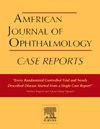Removal of subretinal strands without creating an intentional retinal hole: A case report
Q3 Medicine
引用次数: 0
Abstract
Background
Proliferative vitreoretinopathy (PVR) is a severe vitreoretinal disease. In cases of PVR with subretinal strands (SRS), creating an intentional retinal hole is typically necessary for removing SRS during vitrectomy. Herein, we describe a novel surgical approach for managing total retinal detachment (RD) with SRS.
Case report
A 59-year-old man presented with vision loss in the right eye persisting for four years before the initial presentation. Visual acuity was limited to light perception. The right eye had a mature cataract, and ultrasound computed tomography indicated total retinal detachment. Consequently, combined cataract surgery and vitrectomy were performed on the right eye. After cataract surgery, vitrectomy was performed using a 27-gauge, four-port system. SRS were identified in all quadrants. A fifth port was created approximately 12 mm from the corneal limbus, facilitating the removal of SRS without an intentional retinal hole. Almost all the SRS were successfully removed through this port using vitreous forceps. Postoperatively, the fundus remained stable without complications such as choroidal hemorrhage. No retinal re-detachment was observed during 13 months of follow-up.
Conclusion
The subretinal port provided an effective means of removing SRS without creating an intentional retinal hole in this case of total RD with SRS. This technique could be applicable to similar cases of total RD.
去除视网膜下链而不造成有意的视网膜孔:1例报告
背景:增生性玻璃体视网膜病变(PVR)是一种严重的玻璃体视网膜疾病。在PVR伴有视网膜下链(SRS)的情况下,在玻璃体切除术中,通常需要创建一个有意的视网膜孔来去除SRS。在此,我们描述了一种新的手术方法来管理全视网膜脱离(RD)与SRS。病例报告一名59岁男性,在初次出现之前,右眼视力下降持续了四年。视敏度仅限于光感知。右眼有成熟白内障,超声计算机断层扫描显示视网膜完全脱离。因此,对右眼行白内障联合玻璃体切除术。白内障手术后,玻璃体切除术使用27号,四端口系统。在所有象限中都发现了SRS。在距角膜边缘约12mm处建立第五个孔,方便在不故意形成视网膜孔的情况下移除SRS。几乎所有的SRS都成功地通过这个端口使用玻璃体钳移除。术后眼底稳定,无脉络膜出血等并发症。随访13个月未见视网膜再脱离。结论视网膜下孔为全RD合并SRS提供了一种有效的去除SRS的方法,而不会造成故意的视网膜孔。该技术可适用于类似的全RD病例。
本文章由计算机程序翻译,如有差异,请以英文原文为准。
求助全文
约1分钟内获得全文
求助全文
来源期刊

American Journal of Ophthalmology Case Reports
Medicine-Ophthalmology
CiteScore
2.40
自引率
0.00%
发文量
513
审稿时长
16 weeks
期刊介绍:
The American Journal of Ophthalmology Case Reports is a peer-reviewed, scientific publication that welcomes the submission of original, previously unpublished case report manuscripts directed to ophthalmologists and visual science specialists. The cases shall be challenging and stimulating but shall also be presented in an educational format to engage the readers as if they are working alongside with the caring clinician scientists to manage the patients. Submissions shall be clear, concise, and well-documented reports. Brief reports and case series submissions on specific themes are also very welcome.
 求助内容:
求助内容: 应助结果提醒方式:
应助结果提醒方式:


